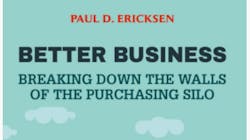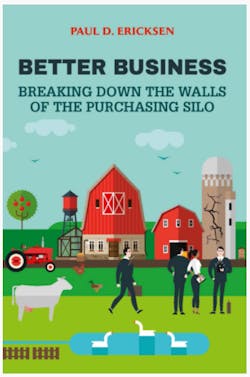Supply Chain Wisdom from the School of Hard Knocks
Original Equipment Manufacturer (OEM) purchasing practices, as they are applied today, aren’t up to the task. And they haven’t been for a very long time. For instance, if you look into it, you’ll find that there is very little difference in how Ford purchased material for their Model-T and how Boeing purchases parts for their 787.
Sure, email, the internet and other computer-based Apps have streamlined processes but, if you were to resurrect a buyer that had worked in Ford’s Rouge River plant when it opened in 1919, I’m pretty sure that person would be able to quickly fit right in at modern purchasing departments. Why? Because there’s really very little difference between the traditional three quotes and a cloud of dust quoting process and today’s “streamlined” three keystrokes and a cloud of dust.
A similar comparison can be made between the purchasing strategies applied by Ford in those early days and those used by OEMs today, in spite of the significant evolution seen in other functional areas over the intervening 100 years. Changes that, by the way, have dramatically improved the business results delivered by those functions. Yet purchasing performance continues to be judged almost exclusively on whether year-to-year material cost (piece-prices) go up or down, and by how much. So in essence, the financial contribution that purchasing makes to corporate business results has remained constant for generations, in spite of changes in all other areas of business.
For the most part, purchasing impacts beyond those associated with initial piece-price and piece-price reduction have remained under the radar. Sure, Covid-19 brought attention to some gaps in current purchasing strategy and practice, but many more are still not acknowledged in the corporate world. It would seem to make a lot of sense to address these “hidden” gaps at the same time as those related to Covid-19 are being addressed. Hopefully, this will happen.
There is a general recognition among OEMs that the value equation offered by individual suppliers can be above and beyond that which can be achieve through a solitary focus on piece-price, but for the most part, the elements of this value-add are considered “soft,” relying too much on anecdotal stories to be noticed by corporate executives. What is needed, instead, is a way to quantify supplier value-add in concrete numbers such that it will catch their attention. A great way to accomplish this would be to show that supplier value-add capabilities —or lack thereof—can either positively (or negatively) impact executive level performance metrics! If this can be demonstrated I guarantee the issue of supply chain value-add—and strategies/processes on how to harvest them—will be a subject at CEO staff meetings.
I’ve written a book titled Better Business: Breaking Down the Walls of the Purchasing Silo that I believe accomplishes this. The first part of the book lays out the financial justification for OEMs changing their purchasing strategies and processes, while the second part offers a tried-and-true, step-by-step process for rolling out to suppliers what is necessary to build the world-class supply base needed to expand the positive financial impacts delivered by purchasing.
This is my first book and I believe the end product is very good. But don’t take my word for it—I was very fortunate to get people very familiar with both business and supply chain to review Better Business. Here is some of the feedback I received:
In my opinion, anyone in America who makes something—anything—and wishes to increase the competitiveness of their firm should read this book and act on the lessons contained therein.
Benjamin Treuhaft, Co-CEO, Helpful Engineering
Paul Ericksen uses his decades of purchasing experience along with engaging examples to explain why supply chains are a key strategic asset and should be managed as such. In this book, practicing managers will learn how source selection and supplier management based on “true” supplier lead-times (rather than piece-price) delivers both better financial results and improved supply-chain performance. Perhaps just as important, in the second half of the book Ericksen provides a step-by-step process on how to financially justify adoption of his new strategies and processes at a company’s C-Level.
Susan Helper, former Dept. of Commerce chief economist, and economics professor, Weatherhead School
This is a rare book on corporate management, combining an insider’s view with an outsider’s perspective. Paul Ericksen presents a strategy for how fundamentally transforming the purchasing function, from an often counter-productive focus on material cost to a broader focus on lean supply chain management, will result in improved company financials. He articulates an outside-the-box strategy for developing supplier capabilities to reduce order fulfilment risk and increase manufacturing agility. At the same time, he provides an insightful analysis of corporate culture, including astute observations on leadership and how to make the business case for lean supply chain performance. Every corporate executive and purchasing manager should read this book.
Matt Vidal, associate professor, Institute for International Management, Loughborough University
We live in a world where supply chains can become a crucial source of competitive advantage but, too often, are not.Why? Because many executives don’t really understand what parts actually cost because they are not properly accounting for time. Paul Ericksen offers a solution. He provides a new understanding of what it means to get lean and how that relates to developing a supply chain advantage.
Josh Whitford, associate professor of sociology, Columbia University
This type of feedback confirms—at least in my mind—that I did a fairly good job putting this book together.
The book is now in the publishing process and available for pre-order. I’m hoping I’ve gotten your attention from the above discussion and endorsements. If you are a reader of my bi-monthly column, you will recognize that my style of writing tends to be interesting and informative, yet easy to read. In other words, don’t expect a textbook-like read.
It should be quite evident given today’s supply chain problems that purchasing needs to change. My hope is that this book lays out a common-sense fundamental basis for the need for some of those changes as well as how to justify and implement them.
I hope you read Better Business: Breaking Down the Walls of the Purchasing Silo. If you do, and think it makes sense, please forward the above link to friend and colleagues that also work in business and the purchasing profession.
Paul Ericksen’s book is Better Business: Breaking Down the Walls of the Purchasing Silo. Ericksen has 40 years of experience in industry, primarily in supply management at two large original equipment manufacturers.

